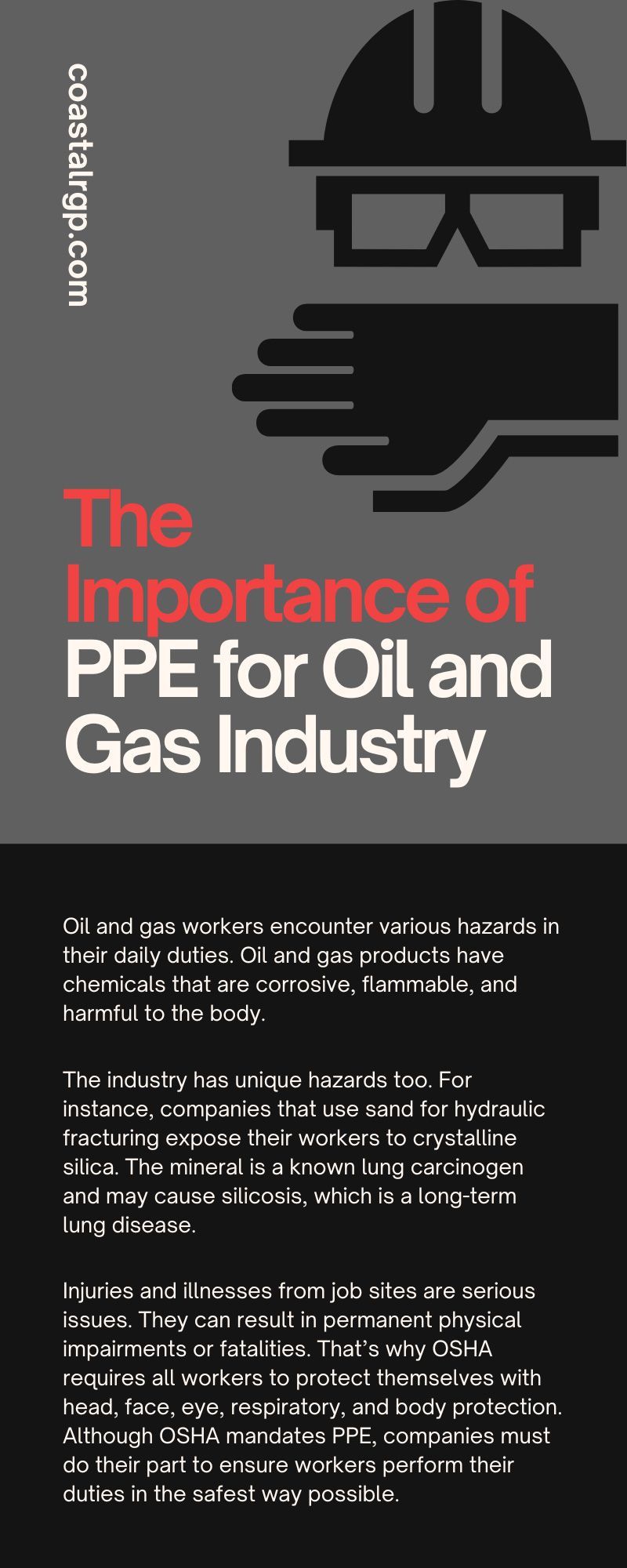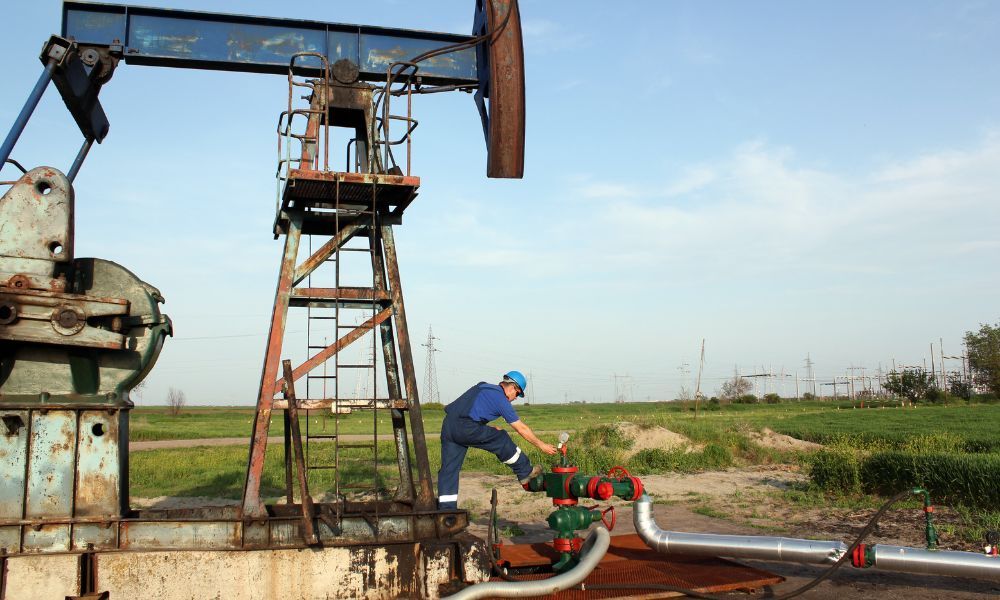Oil and gas industry workers perform dangerous tasks that expose them to multiple hazards. To reduce accidents, companies require workers to wear protective gear. Understand the ins and outs of gear by reading the essential guide to PPE in the oil and gas industry.
What Is PPE?
According to the Occupational Safety and Health Administration, personal protection equipment, or PPE, is equipment worn to minimize exposure to hazards that cause serious workplace injuries and illnesses. The injuries and illnesses may come from contact with electrical, chemical, physical, and mechanical workplace hazards.
Oil and gas industry workers expose themselves to dangerous elements, increasing their chance of accidents. To reduce workplace mishaps, OSHA mandates oil and gas workers to protect their bodies on worksites. Common PPE includes gloves, safety glasses, hard hats, and earplugs. However, gear requirements vary on different sites.
Different manufacturers offer PPE solutions that align with specific hazards. For example, fire-resistant overalls and gloves are popular gear for oil and gas workers. Ultimately, PPE is here to make dangerous workplaces safer.
The Importance of PPE for Oil and Gas Industry
Oil and gas workers encounter various hazards in their daily duties. Oil and gas products have chemicals that are corrosive, flammable, and harmful to the body.
The industry has unique hazards too. For instance, companies that use sand for hydraulic fracturing expose their workers to crystalline silica. The mineral is a known lung carcinogen and may cause silicosis, which is a long-term lung disease.
Injuries and illnesses from job sites are serious issues. They can result in permanent physical impairments or fatalities. That’s why OSHA requires all workers to protect themselves with head, face, eye, respiratory, and body protection. Although OSHA mandates PPE, companies must do their part to ensure workers perform their duties in the safest way possible.
Choosing PPE: Hazard Identification
OSHA determines industry-specific PPE through a Site Hazard Identification and Risk Assessment. This involves a consultation with workers to identify all potential hazards on worksites. Common sources of risks include mechanical hazards like oily surfaces, potential flash fires, and chemical exposure.
To minimize risks, professionals apply the “Hierarchy of Control,” where they should eliminate hazards if possible. Companies should include PPE to protect against residual hazards if it’s impossible.
It’s important to understand that hazard identification is the employer’s responsibility (under OSHA’s 1910. 132 section). This initiative pushes companies to acknowledge unsafe areas and consider all the things that may go wrong.
Matching PPE to Hazards
When selecting PPE, you should look for various factors. In particular, it’s important to select garments that match hazards because they provide the best level of protection. Here’s a breakdown of the critical properties that PPE offers.
Flame Resistance
Garments either have “inherent” or “treated” flame-resistant technologies. Inherent means that fire-resistant properties are a natural part of fibers in the fabric. This is a permanent addition to fabric and cannot be worn out or washed away. Treated fabrics have chemical additives that make fabric flame-resistant.
When companies seek flame-resistant garments, it’s critical to distinguish inherent and treated fabrics. Though both are suitable options, it’s best to choose long-lasting material, which is inherent treated fabrics.
Chemical Exposure
Chemicals can burn skin, change pigmentation, cause skin irritation, and may even result in skin cancer. That said, PPE garments must offer suitable protection to prevent exposure. Ideally, garments have a strong permeation barrier that protects the wearer from various hazardous substances and chemicals.
PPE should also repel low concentrations of inorganic liquids and aerosols and prevent solid particles from penetrating skin. To ensure full protection, companies must test garments to see if PPE protects against chemicals found on their worksites. Employers should ask garment manufacturers to provide permeation data for specific chemicals.
Cut Hazards
For the oil and gas industry, workers will likely encounter cut hazards in combination with chemical exposure or extreme temperatures. Duties like welding and brazing include exposure to metal fumes and UV radiation. So, sharp tools and chemicals—and even extreme temperatures—can result in accidents.
With these hazards, workers need protective yet flexible gear. Some PPE manufacturers offer gloves that safeguard hands without compromising the worker’s ability to perform duties, such as holding tools or operating equipment.
Electrical Hazards
Electrical hazards are among the most serious dangers on worksites, but many overlook their severity. In particular, an electric arc flash is a continuous electric discharge that flows through gaps between conductors. It generates intense heat and ultraviolet light.
Injuries from electric arc flash include third-degree burns, nerve damage, hearing loss, blindness, cardiac arrest, or death. Selecting PPE that shields workers from an arc flash is critical for job sites, especially for workers stationed near electrical currents.
The Essential PPE
As mentioned, PPE covers the head, face, eye, and respiratory system, as well as providing full-body protection. This comes in the form of protective garments and accessories. The essential PPE includes the following:
- Body garments – Flame-resistant garments that protect employees’ bodies from elements on jobsites.
- Safety glasses – Worksites accumulate dust, sand, grease, and flying debris. Particles can obstruct vision and damage the eyes. Workers wear safety glasses to shield their eyes from flying items.
- Gloves – Work gloves shield hands from chemical exposure. Workers also use them for cutting, welding, or performing specialty jobs.
- Hard hats – Anything can happen on worksites. So, hard hats protect workers from falling objects or struck-by hazards.
- Safety shoes – Employees haul heavy equipment and accessories through drill sites, increasing the risk of dropping items and injuring feet. Safety shoes are typically steel-toe boots that prevent injuries.
- Respirator – To prevent chemical inhalation, workers need respirators. Air-purifying respirators filter airborne particles and chemicals.
How Companies Ensure Compliance
Of course, PPE is mandatory for oil and gas industry workers. But OSHA representatives aren’t on worksites every day. So, how do companies ensure compliance? The answer is safety training. Employers provide PPE training that discusses the importance of each garment.
Workers learn how to wear and maintain equipment. In case of equipment damage, trainers tell employees to discard tattered garments and get new ones. No one should risk their health and safety at work. Thus, providing ongoing training and enforcing PPE policies ensures that workers are familiar with all the necessary safety practices.
A safe workplace is an efficient and productive one. Employees should perform tasks without risk of injuries or illnesses. That’s why wearing PPE is critical for industry workers. Always refer to the essential guide to PPE in the oil and gas industry for a refresher on mandated gear.
If you’re interested in oilfield safety supplies, consider Coastal Resource Group as your supplier. We have industrial safety products for different applications. Call us today to see how we can help!



